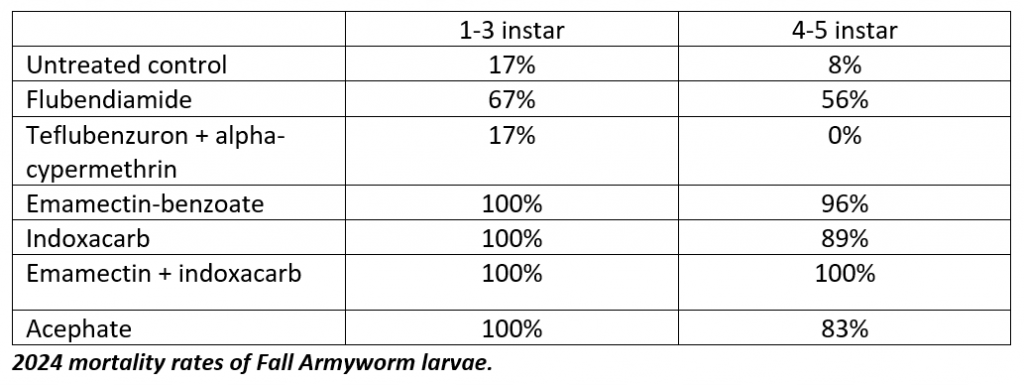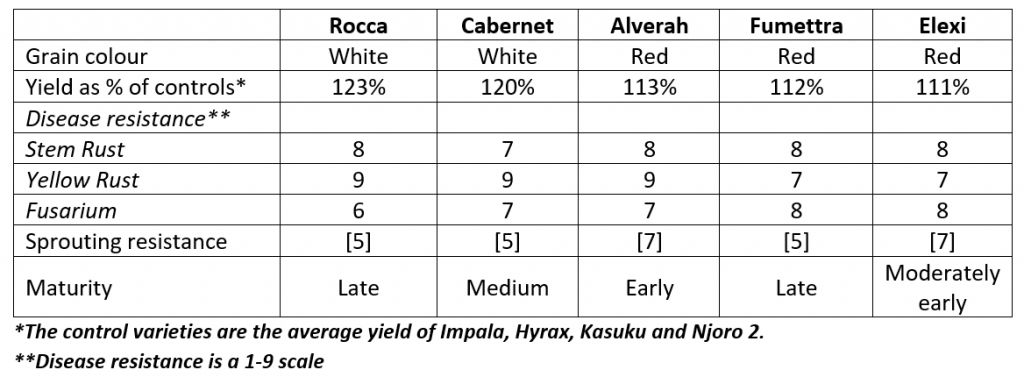![[THINK AGRONOMY] Pre-Harvest Sprouting](https://cropnuts.com/wp-content/uploads/2024/09/Cropnuts-Website-Header-13.png)
This will be a harvest that is unfortunately remembered for many years to come, for pre-harvest sprouting in wheat. We can’t say we couldn’t have seen it coming after a run of fairly easy, dry harvests but what is different about this harvest is that we have generally moved away from the highest-risk varieties like Kasuku, and we are seeing it in varieties that are generally considered at very low risk of sprouting.
Once in a while these harvests happen, where it seemingly rains every day for weeks then months. Essentially the grain is germinating prematurely. As much as we lament this, don’t forget that any seed has one job to do…
Sprouting is controlled to a large extent by the genetics of the variety, with enzymes breaking down starch and initiating germination much more quickly in some varieties. Amongst the farms I advise on, we moved away from Kasuku and Korongo a few years ago for this exact reason.
This breakdown and degradation of starch is what reduces baking quality in the flour, and is reflected in a Hagberg Falling Number test. This is a way of measuring the dough extensibility by dropping a plunger through a flour paste and timing how long it takes. Importantly, even if you cannot see visible sprouts on the grain, the baking quality could still have deteriorated.

Seed coat hardness also matters; harder seed coats are actually more likely to germinate as their rate of water uptake is a lot quicker than softer seed coat varieties – which is somewhat counter intuitive.
White wheats are generally worse for sprouting than reds, although there are exceptions to this. Impala for example is a white wheat that is relatively slow to sprout (although I would not wager on it!), whilst Kasuku is a red which can sprout before it is even physiologically mature.
Whatever the variety, rainfall, temperature and humidity play a key role. Rain at harvest is the obvious factor, but humidity stops the grains from drying out, which is why lower altitudes tend to be more at risk of sprouting where more water vapour is held in the air. Wet soil of course constantly evaporates and creates a humid microclimate in the crop.
Temperature is often overlooked and has a big impact on seed dormancy. Cool temperatures as the crop matures tend to result in grains being more dormant and less liable to sprouting, hence higher altitudes are often associated with lower sprouting risk.
What can be done? Planning harvest timing is the biggest single thing we can do to manage the risk. Assuming that September will be relatively dry and low-risk across most of the country, planting in April or May depending on altitude is the first step. This is not ideal for yields, however, as the crop is likely to be grain-filling in drier and overcast conditions.
January and February are also usually dry across most of the country in all but El Niño years; 1998 in Mau Narok for example, or 2019 across much of the country.
Choosing a variety with relatively good sprouting resistance is the next step. Robin, Hawk and Kwale are amongst the best but are far outclassed in yield and disease these days. Mwera is very good, as was candidate AGV 249 and Hyrax, yet I have seen sprouting in all three of these in very unexpected situations recently.
All of our varieties have a very similar length of maturity which does not help, especially when planting in March for a September harvest window. For me, the longer-term answer lies in growing a range of varieties with different maturities and planting dates and having a clear plan and manageable area at harvest.
Since its arrival in 2017, there have been some devastated crops and serious losses from the pest in not only maize but also sorghum and occasionally wheat and barley. I had felt that it was becoming less prevalent over the years, but 2023 definitely saw more reports of damage than any recent years.

One thing is for sure, Fall Armyworm is here to stay and we need to learn to adapt, monitor and manage the threat. Every few years I do a simple pot test on Fall Armyworm to look at the efficacy of the various insecticides available and to gauge whether they are maintaining their effectiveness.
The test involves collecting Fall Armyworm for a maize crop that has not recently received an insecticide, segregating them into small 1-3 instars and larger 4-6th instars, and placing them in pots with fresh maize leaves.
The chemical is immediately applied to the pots at recommended field concentrations and the mortality is assessed after five days. We always have four larvae in each pot, and four pots for each treatment to ensure that the test is replicated.
It is really important to be clear about what the limitations are of this method; what it tells us and what it does not. It does not tell us about the residual effects of chemical or ovicidal activity, for example what happens if an egg hatches and a larvae ingests leaf material sometime AFTER it has been treated.
Some chemicals have greater persistence in or on the plant than others (none of these chemicals are particularly systemic which helps remove an area of debate around the protection of new growth after a plant has been treated).
It also does not inform us about any repellence effect on the adult moths laying their eggs, which can have a short-term effect on how quickly the pest re-establishes in a crop, nor can it inform us about the safety of the chemical to natural predators of Fall Armyworm.
We also cannot test every formulation of every active ingredient, so the advice is to buy wisely from a reputable source, whether from an original or quality generic manufacturer.
What this test does do is to objectively measure the control from different active ingredients in a controlled manner, at different stages of the larvae that we might be targeting in the field. It removes the effect of the enormous variation that occurs across a field (plot trials with Fall Armyworm are notoriously difficult and involve very tedious, destructive work to properly assess actual mortality). This is really important as many subjective or anecdotal observations are made which confuse variation of populations across a field.
Remember that control starts with planning and the use of cultural methods before we think about chemicals; anecdotally I see a lot less damage from healthier plants with good nutrition, strong root systems and the ability to keep their momentum when under attack from the pest. Crop rotation matters and its benefit to allowing the crop to resist attacks is hugely underestimated.
I cannot believe that this is the result of lower moth pressure as they will readily fly several kilometres to new crops, but I see a lot less damage in maize crop in varied rotations.

Amongst the 1st to 3rd instar treatments, indoxacarb, emamectin and acephate provided full control, and in fact within 3 days. Flubendiamide was slightly less effective, and newly test teflubenzuron showed only 17% mortality. Given that this was the same level of natural mortality observed in the untreated control, it is unlikely that teflubenzuron contributed any control.
At the larger larvae stages, flubendiamide was slightly less effective, teflubenzuron provided no control (all of the larvae were still alive in all replicates), emamectin, indoxacarb and acephate could not quite achieve full control, and only a mix of emamectin and indoxacarb together resulted in 100% mortality.

Comparing the results with previous tests in 2021 and 2018, nothing is performing any worse than six years ago, with the possible exception of acephate. We did not have chlorantraniliprole available on this occasion but that has performed similarly to emamectin, acephate and indoxacarb in previous years. Flubendiamide has been consistently around 50% in the past two tests. Lufenuron and spinetoram were not trialled this year as they seldom provide effective control on Fall Armyworm.
Overall it is encouraging that the chemistry is still working effectively, but it is important to rotate and not to over-rely on a single active ingredient or group. There are a lot of things that can be done to improve results on the farm by maintaining sprayers well, applying the product in the evening or morning, and focusing on strong, healthy plants.
With Impala and Kasuku breaking down to Stem Rust, Jacana not quite living up to our hopes with variable grain quality and only Hyrax – whose yields are not an improvement – remaining, farmers are sorely in need of good alternative varieties.
Five new wheats have been entered into National Performance Trials this season, with the hope that some or all of them become registered in the coming years. This is a long way off, unfortunately. The process has to be meticulous in order to properly scrutinise the varieties and understand any weaknesses.

Three new red wheats and two new white grains are included, which have shown consistent and repeatable improvements in at least six trials over the past 12 months across a range of environments. These should also bring good Stem Rust, Yellow Rust and Fusarium resistance to farmers.
For the time being we have limited data on sprouting and Glume Blotch and all of the ratings can change as diseases mutate and new trial sites uncover problems that hitherto had not been observed.
Fumettra looks very interesting and were it not for one poor trial which we can likely attribute to a compromised plot, it would have yielded around 20% above the average of the current control varieties. It is late maturity, but it stands well and has excellent Stem Rust resistance. Provisional results suggest that the variety is only moderately resistant to sprouting, but more information and experience is needed.

Elexi and Alverah are earlier maturing red varieties – similar to Kasuku and Impala – and still possess very high yield potential. Elexi has a very upright growth habit, so it may be a variety that performs better in narrower rows or at higher seed rates. If the variety continues to progress, we will explore this further.
Of the white grain varieties Rocca and Cabernet have produced consistently high yields, but will always be limited as will any white grain wheat by the heightened risk of sprouting. They do possess very good diseases resistance, albeit with Rocca showing late maturity and similar resistance to Fusarium as Korongo did. Rocca does tiller very readily and has impressed in tough conditions in Laikipia. Keep following the newsletter for updates on the progress of these varieties over the coming months.
Till next time,
David Jones,
Independent Agronomist
How would you rate our article?

David is an independent agronomist in Kenya and a member of the Association of Independent Crop Consultants. David gives independent advice based on scientific trials and experience. Currently works with the Centre of Excellence for Crop Rotation.
Think Agronomy is brought to you by Cropnuts and the Centre of Excellence for Crop Rotation. We share the same vision for sustainable, dryland farming across Africa, and Think Agronomy is our independent voice to promote profitable, climate-resilient farming through better management of soil health, systems-based agronomy, crop diversification, and farm mechanization.
Order our services and get to know how to improve your soil for better yeilds.